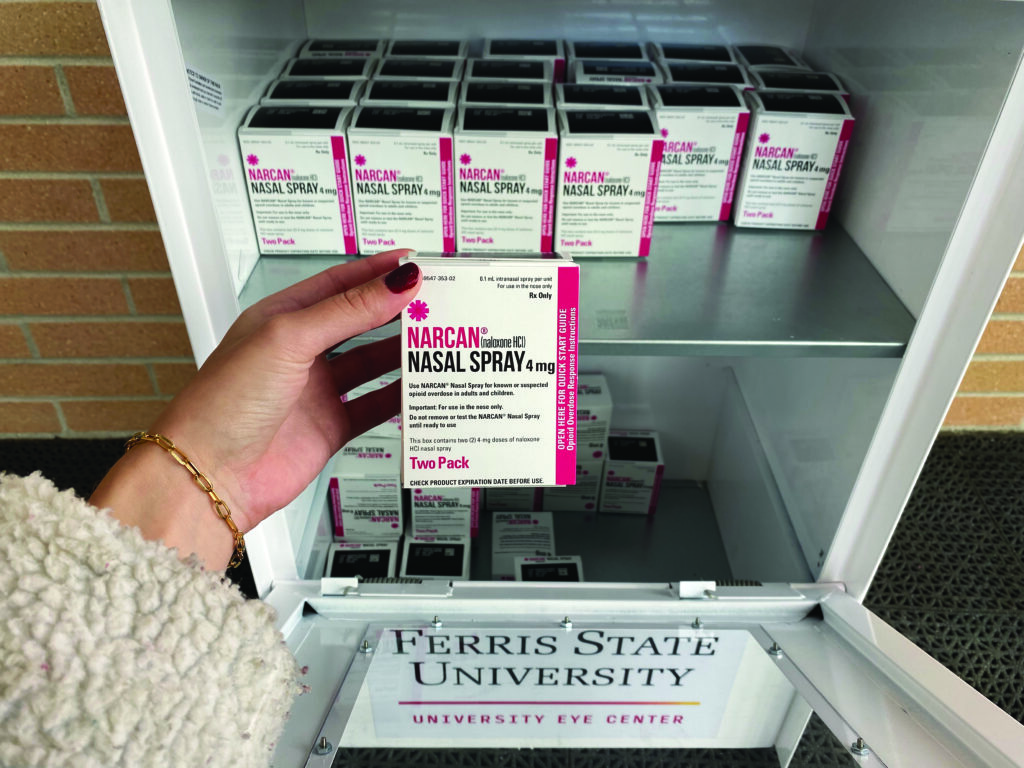With grant funds from late July, Ferris’ Central Michigan Recovery and Education Network now allows the university to place Narcan dispensers around campus, helping combat the detrimental consequences of rising opioid usage.
USAFacts reported 200 daily opioid deaths in America last year. That would be the equivalent of the entire student body at Ferris State University in less than three months.
Biology junior CJ Crabtree, a student focusing on pre-physician assistant studies, has personal experience in this movement to decrease opioid-related deaths.

“I helped Dr. [Gail] Bullard on campus put together and distribute the Narcan boxes. I think these boxes are such a big help for everyone to have access to,” said Crabtree.
Bullard is program coordinator for the Master of Healthcare Administration and project director for the Central Michigan Recovery and Education Network.
Crabtree stated, “Many students I have interacted with do not know what Narcan is. By keeping this topic open and informing students, we can reduce the stigma around using Narcan and help people get access to the resources they need,”
Not only were these dispensers placed at the Big Rapids Community Library and the Michigan College of Optometry building, but they were also donated to Corewell Health, which distributed these items to surrounding counties.
Through HRSA’s Rural Communities Opioid Response implementation project, the program was funded with a four-year federal grant containing $1.2 million.
Since then, there have been many educational prevention campaigns and events for substance use disorder.
“As we neared the end of the grant, we wanted to be sure that we were giving things back that were visible and meaningful to the community,” Bullard said.
Their program has placed a work order to put more Narcan dispensers above the AEDs on campus.
“I personally think that they are a good thing to have around, but people need to be educated before it’s dispersed like that,” Medical laboratory science senior Allison Mony said, “Anything that’s health and emergency related, people should be trained on it before use.”
Narcan, a brand of the generic naloxone, is a nasal spray that is used to save individuals suffering from an opioid overdose.
Some people are worried that it may be harmful if used when unneeded. Narcan is not hurtful if accidentally used, as it only works when opioids are in the person’s body. The antidote binds to the drugs and brings it right out of their system.
After the spray is applied, it gives a withdrawal effect causing the victim an irritating and miserable feeling.
Bullard explained that by having these readily available, lives could be saved. There are cases in which even buying a different drug could be laced.
“Substance use disorder is a disease,” Bullard said. “The real deal is, don’t buy anything off the street, and don’t misuse drugs.”
It could start with recreational use or even be genetic makeup as to why it’s an issue. It takes up to at least two years for the brain changes that have occurred to recover. The Narcan boxes can be a start to that recovery.
At pharmacies, Narcan can be sold to an uninsured person with a price ranging from $250 to $300 a box, which is good for one dosage administration. In some places, the cost of Narcan is being reduced to $50.
It still may not be easily attained for people suffering from substance use disorder. This is why Bullard shares the importance of letting the public know that they are making it as accessible as possible.
